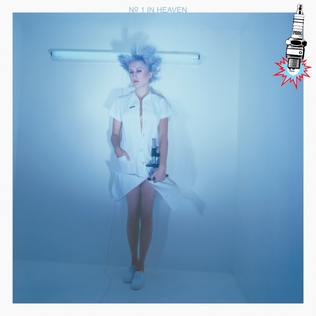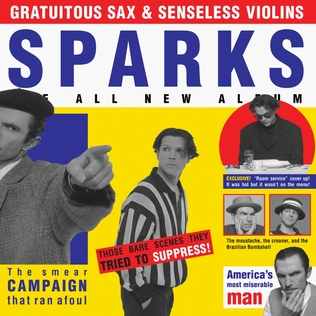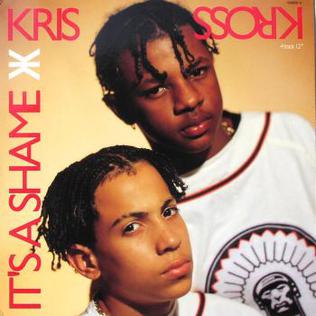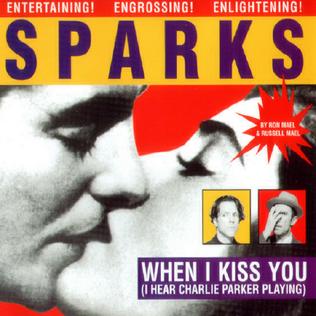
Sparks is an American pop and rock duo formed by brothers Ron (keyboards) and Russell Mael (vocals) in Los Angeles. The duo is noted for their quirky approach to songwriting; their music is often accompanied by sophisticated and acerbic lyrics—often about women, and sometimes containing literary or cinematic references—and an idiosyncratic, theatrical stage presence, typified by the contrast between Russell's animated, hyperactive frontman antics and Ron's deadpan scowling. Russell Mael has a distinctive wide-ranging voice, while Ron Mael plays keyboards in an intricate and rhythmic style. Their frequently changing styles and visual presentations have kept the band at the forefront of modern, artful pop music.

"Jump" is a song by American hip hop duo Kris Kross, released on February 6, 1992, as their first single from their debut studio album, Totally Krossed Out (1992). It achieved international success, topping charts in Switzerland, Australia, and the United States. Additionally, it was the third-best-selling song of 1992 in the United States, with sales of 2,079,000 physical copies that year. The song's accompanying music video was directed by Rich Murray and filmed in Atlanta. Billboard magazine featured "Jump" in their lists of "Billboard's Top Songs of the '90s" in 2019 and "500 Best Pop Songs of All Time" in 2023.

Kimono My House is the third studio album by American rock band Sparks, released on May 1, 1974, by Island Records. The album is considered to be their commercial breakthrough, and was met with widespread acclaim.

"Girls & Boys" is a song by the English rock band Blur, released in March 1994 by Food Records as the lead single from the group's third studio album, Parklife (1994). Charting at number five on the UK Singles Chart, "Girls & Boys" was Blur's first top-five hit and their most successful single until "Country House" reached number one the following year. The single surpassed their previous commercial peak "There's No Other Way" by three spots on the UK Singles Chart and saw the group achieve greater worldwide success. In the US, the track reached number 59 on the US Billboard Hot 100 chart, becoming the band's second single to enter the chart after "There's No Other Way". It also reached number four on the Billboard Modern Rock songs chart. Frontman of Blur, Damon Albarn wrote the song's lyrics with bandmembers Graham Coxon, Alex James and Dave Rowntree, while Stephen Street produced it.

"Here I Go" is a song by Belgian/Dutch Eurodance group 2 Unlimited. It was co-written by band members Ray Slijngaard and Anita Dels and was released in March 1995 as the third single from their third album, Real Things (1994). In the United States, the song was released as a double A-side single with 2 Unlimited's next European single, "Nothing Like the Rain". "Here I Go" became a top-10 hit in at least five countries: Belgium, Finland, Lithuania, the Netherlands, and Spain. Its music video was directed by Nigel Simpkiss.

"This Town Ain't Big Enough for Both of Us" is a song by American pop band Sparks. Written by Ron Mael, it is the opening track on their third studio album Kimono My House (1974), and was the lead single from the album. Although it did not chart on the Billboard Hot 100, "This Town Ain't Big Enough for Both of Us" achieved major success in Europe, peaking within the top ten of the charts in the Netherlands, Switzerland and the United Kingdom. In the latter country, the song peaked at number two on the UK Singles Chart, where it remained for two consecutive weeks. The song has become the highest-charting for Sparks on the UK Singles Chart, held off from the top spot by The Rubettes' bubblegum pop song "Sugar Baby Love".

Nº 1 in Heaven is the eighth studio album by American rock band Sparks. Recorded with Italian disco producer Giorgio Moroder, the album marked a change of musical direction for the group and became influential on later synth-pop bands.

Gratuitous Sax & Senseless Violins is the 16th album by American rock band Sparks. It was released in 1994, after an absence from the music industry of 6 years, and marked the duo's transition into a more techno/Eurobeat-influenced sound, which earned them popularity in Germany.

Plagiarism is the 17th album by American rock band Sparks. It is a tribute album of sorts featuring new alternate versions of some of their best known songs.

Lil' Beethoven is the 19th album by the American rock band Sparks, released on November 26, 2002. The album was a radical musical departure compared to their previous works. The band only used strings, piano, and voices but sporadic drums: the result was both classical and pop music.

"I Wanna Be Down" is the debut single of American recording artist Brandy from her self-titled debut album (1994). It was written by musicians Keith Crouch and Kipper Jones, with production helmed by the former, it was released on September 5, 1994, by the Atlantic Recording Corporation. The song is a mid-tempo track that features a thunderous beat and light synth riffs. Lyrically, "I Wanna Be Down" describes a flirt with a boy, who Norwood tries to convince of her loveliness.

"Saturday Night" is a song by Italian Eurodance project Whigfield, fronted by Danish-born Sannie Charlotte Carlson. It was first released in 1992 in Italy and 1993 in Spain through Prodisc. Throughout 1994, it was released across the rest of Europe and experienced worldwide success. The song was written by Italian producers Larry Pignagnoli and Davide Riva and produced by Pignagnoli. In 1995, the song was included on Whigfield's debut album, Whigfield.

"It's a Shame" is the fourth and final single released in January 1993 by American duo Kris Kross from their debut album, Totally Krossed Out (1992). It is the least successful of the four singles, as it did not chart on the Billboard Hot 100. However, it did manage to reach number 11 on the Billboard Hot Rap Singles chart and number 55 on the Hot R&B/Hip-Hop Songs chart and number 31 on the UK Singles Chart. The song was written and produced by Jermaine Dupri. The group had performed "It's a Shame" on numerous television shows such as A Different World.

"Dreamer" is a song by Italian house group Livin' Joy, written and recorded by Janice Robinson and produced by brothers Paolo and Gianni Visnadi. Originally released in August 1994, it was re-released in 1995 by MCA and topped the UK Singles Chart at the number one spot that May, ending 1995 as the UK's 40th-biggest-selling single of 1995. In the United States, it went to number-one on the Billboard Hot Dance Club Play chart. It was a sleeper hit on pop radio, but finally managed to peak at number 72 on the Billboard Hot 100 and number 75 on the Cash Box Top 100.
The following is a comprehensive discography of Sparks, an American rock and pop music band formed in Los Angeles in 1970 by brothers Ron (keyboards) and Russell Mael (vocals), initially under the name Halfnelson. Best known for their quirky approach to songwriting, Sparks' music is often accompanied by cutting and acerbic lyrics, and an idiosyncratic stage presence, typified in the contrast between Russell's wide-eyed hyperactive frontman antics and Ron's sedentary scowling.

"Rock My Heart" is a song by Trinidadian-German musician Haddaway, released in March 1994 as the fourth and final single from his debut album, The Album (1993). It was written and produced by Dee Dee Halligan and Junior Torello. Like the previous single "I Miss You", the song was a hit in several countries, particularly in the UK, Germany, Finland, Switzerland, Ireland and Belgium, where it reached the top 10. In Israel, it peaked at number one for two weeks. "Rock My Heart" shot into the Eurochart Hot 100 at number 17 on 9 April 1994 and peaked at seven four weeks later.

"Be Happy" is a song by American singer Mary J. Blige. It was written by Blige, Sean "Puffy" Combs, Arlene DeValle, and Jean-Claude Olivier from duo Poke & Tone for her second studio album, My Life (1994), while production was helmed by Combs and Olivier. "Be Happy" contains an instrumental sample of the song "You're So Good to Me" (1979) by musician Curtis Mayfield and a re-sung vocal portion of the record "I Want You" (1976) by Marvin Gaye.

"Shoop" is the lead single released from American hip hop group Salt-N-Pepa's fourth studio album, Very Necessary (1993). The song was produced by group members Sandra "Pepa" Denton and Cheryl "Salt" James with Mark Sparks. It features an uncredited verse by rapper Otwane "Big Twan Lov-Her" Roberts. Released in September 1993 by Next Plateau, the song became one of the group's more successful singles, reaching number four on the US Billboard Hot 100 and topping the Hot Rap Singles chart at number one. Two months after its release, "Shoop" was certified gold by the RIAA; it went on to sell 1.2 million copies. Its accompanying music video was directed by Scott Kalvert. The success of both this single and the follow-up single "Whatta Man" propelled Very Necessary to sell over 5 million copies in the US, becoming the group's best-selling album.

"None of Your Business" is the third single from American hip hop group Salt-n-Pepa's fourth studio album, Very Necessary (1994), released in August 1994 by Next Plateau. Written and produced by Hurby Azor, the song earned the group its first Grammy Award. It is included on the 1996 Barb Wire and 2000 Miss Congeniality soundtracks.

"When I Kiss You (I Hear Charlie Parker Playing)" is a song by American rock band Sparks, released in February 1995 by Logic Records as the second single from their 16th album, Gratuitous Sax & Senseless Violins (1994). Written and produced by the Mael brothers, it also has a reference to American jazz saxophonist Charlie Parker. The song peaked at number 36 in the UK, number 61 in Germany and number 24 on the Billboard Hot Dance Club Play chart in the US. Originally it was released as "(When I Kiss You) I Hear Charlie Parker Playing", before being re-named to its present title. Sophie Muller directed its music video.



















